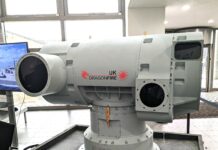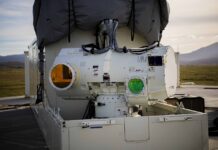Whether for shelters, parachutes, combat clothing, camouflage and more, some highly advanced technologies go into the making of textiles found in the many diverse and demanding applications across today’s operational environments.
Conducting operations in exacting military scenarios for extended periods places huge demands on individual soldiers, airmen and sailors and requires that, as far as is technologically possible, they each be protected by their clothing and equipment from combat hazards and the extreme elements that nature will throw at them. Inadequate protection leaves personnel susceptible to natural, though avoidable, health hazards such as respiratory and other disease, as well as combat dangers such as fire. However, with the right protective gear, injury and worse can be avoided and missions achieved. From the extreme cold of high-altitude environments or polar regions where frostbite and hypoxia are natural dangers, to risks of heat exhaustion in hot, desert locations, even without facing battle threats, soldiers are in constant jeopardy and rely on their clothing and equipment for a serious level of protection. Marines and sailors also confront numerous hazards of conducting operations at sea, and fighter pilots face extreme G-forces. Whether on land, at sea, or in the air, one common threat facing them all during combat is that of the always present danger of fire.
In all of these scenarios, the first important layer of protection is an individual’s clothing, and along with the private sector, extensive research is being conducted at many defence/civil research establishments around the world into the technology of advanced textiles. One such defence establishment is the DEVCOM Natick Soldier Center (SC) in the US, which is responsible, amongst other things, for the technology, research, development, engineering, fielding, and sustainment of US military clothing, shelters, airdrop systems, as well as other soldier support items, with each category involving some of the very latest textile technologies and research. On the civil side in the UK, though with defence partners, is Nottingham Trent University’s Advanced Textiles Research Group (ATRG), which is conducting research into advanced textiles and electronically active wearable technology.
ATRG works closely with leading commercial and defence establishments and along with seven partners, including the UK’s Defence Science and Technology Laboratories (DSTL) and QinetiQ, is currently involved in a major project researching electronically-active yarns, where electronic functionality is embedded within yarns and textiles.
These are just two of the many global organisations at the forefront of textile tech, developing everything from cold weather kits, anti-G suits, flame resistant/retardant (FR) materials for combat uniforms, nuclear/biological/chemical protective suits and much more. With special material properties to suit specific applications, technical textiles are designed to minimise attrition among a fighting force, whether resulting from natural or combat threats.
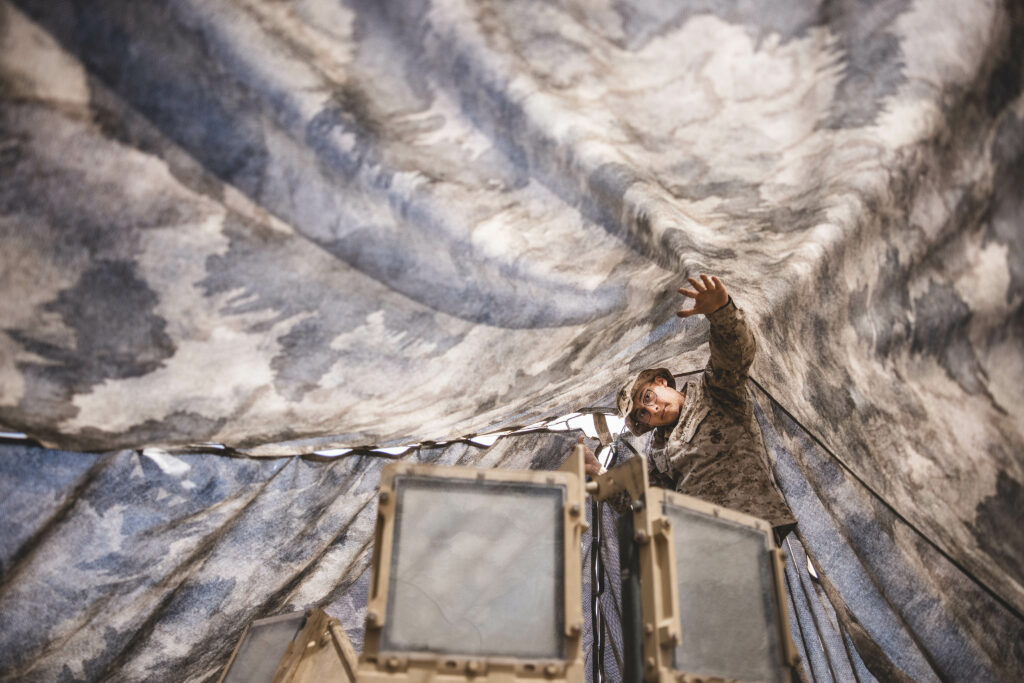
Credit: USMC/Cpl Meshaq Hylton
What Applications, What Textiles, What Properties
There are two categories of technical textiles used for defence applications. The first includes materials incorporated into defence systems, such as parachutes and harness lines, seating materials, internal vehicle finishings, materials (fire resistant/retardant; FR) for tents, tarpaulins and shelters such as field hospitals. The second encompasses individual equipment and clothing, from MTP (multi-terrain pattern) camouflaged combat kit, pilot suits, helmets, packs, webbing and carriage solutions, and more.
For tents and shelters, textiles used, whether incorporating natural fabrics such as cotton or synthetics and blended yarns, these must be waterproof and resistant to physical changes under wet conditions (no degradation, no absorption, no expansion), and must also be anti-fungal and FR-treated. They must also be lightweight to aid mobility/transportability, yet tough enough to ensure they remain intact during what also needs to be a fast and easy assembly and deployment process. As well as providing protection from the elements, military tented-style shelters will often offer chemical and biological protection and be designed to avoid infrared and radar detection.
When it comes to parachutes, their critical functions in crucial applications such as individual para drops, equipment/cargo pallet drops, drogue chutes for slowing aircraft on landing, controlled-descent flare chutes and more, demand that their component parts of textile canopy, harness, rip cords and suspension lines are carefully made to exacting standards. Their fabrics, typically high-tensile, nylon, multi-filament yarns of woven ripstop, 32 to 200-denier weave, must be thin and lightweight, yet strong and designed and constructed with an exacting relationship between their strength, weight and air porosity characteristics, with a high overall strength-to-weight ratio. The thin textile allows chutes to be folded to a required volume and the textile’s careful construction will help determine the chute’s air permeability, which, in turn, determines the rate of descent or retardation for a specific application.

In terms of items of individual clothing and ensemble gear, webbing, individual armour, etc, for different scenarios, the main function is to maximise survivability in combat and all weathers, as well as offering effective camouflage properties, protection against ballistic impact and potential chemical, biological and nuclear events. As such, advanced integrated combat clothing must be durable and resistant to extreme weather conditions, with high tensile and tear strength, fabrics might be FR, and display effective abrasion resistance. While displaying such properties, individual clothing must still be comfortable, lightweight and easy to wear.
For the latest body armour produced from technical textiles and fabrics such as Dupont’s Kevlar, DSM Netherland’s Dynema (recently acquired by Avient Corporation in the US), and Teijin Aramid’s high-performance aramid fibres, Technora, Twaron and others, each company has its own manufacturing processes. That said, construction of armour in layers using such fabrics is typically done in a way to ensure each layer reduces and absorbs the energy of an impact by a projectile or shrapnel to its maximum potential, with those fibres impacted dispersing the energy through the weave to adjacent fibres. A plain balanced woven fabric construct, for example, will maximise crossover points and, therefore, the number of paths energy dispersion can take from point of impact.
Fire resistance (FR) is a critical, required characteristic of many protective and personal clothing ensembles, whether for the likes of emergency ground crew at an air base, or firefighting teams aboard naval vessels, as well as for such applications as aircraft seat coverings. Flame retardant/FR fabrics are designed to resist burning and self-extinguish if ignited. The FR properties of a garment are either the result of the textile material itself being inherently flame resistant, such as aramid, PBI (polybenzimidazole) and PFR rayon fibres, or from the textile itself being specially treated with a flame retardant application. Such FR fabrics or treatments essentially must impart a limiting oxygen index (LOI) percentage on a protective garment higher than 21% (the level of atmospheric oxygen in the air), or above, for the textile to be categorised as FR. The LOI is measured by passing a mixture of oxygen and nitrogen over a burning specimen of the textile, and reducing the oxygen level until a critical level is reached, with LOI values also dependent on the surrounding temperature of the fabric sample; the percentage of oxygen required for combustion reduces as the surrounding temperature is increased.
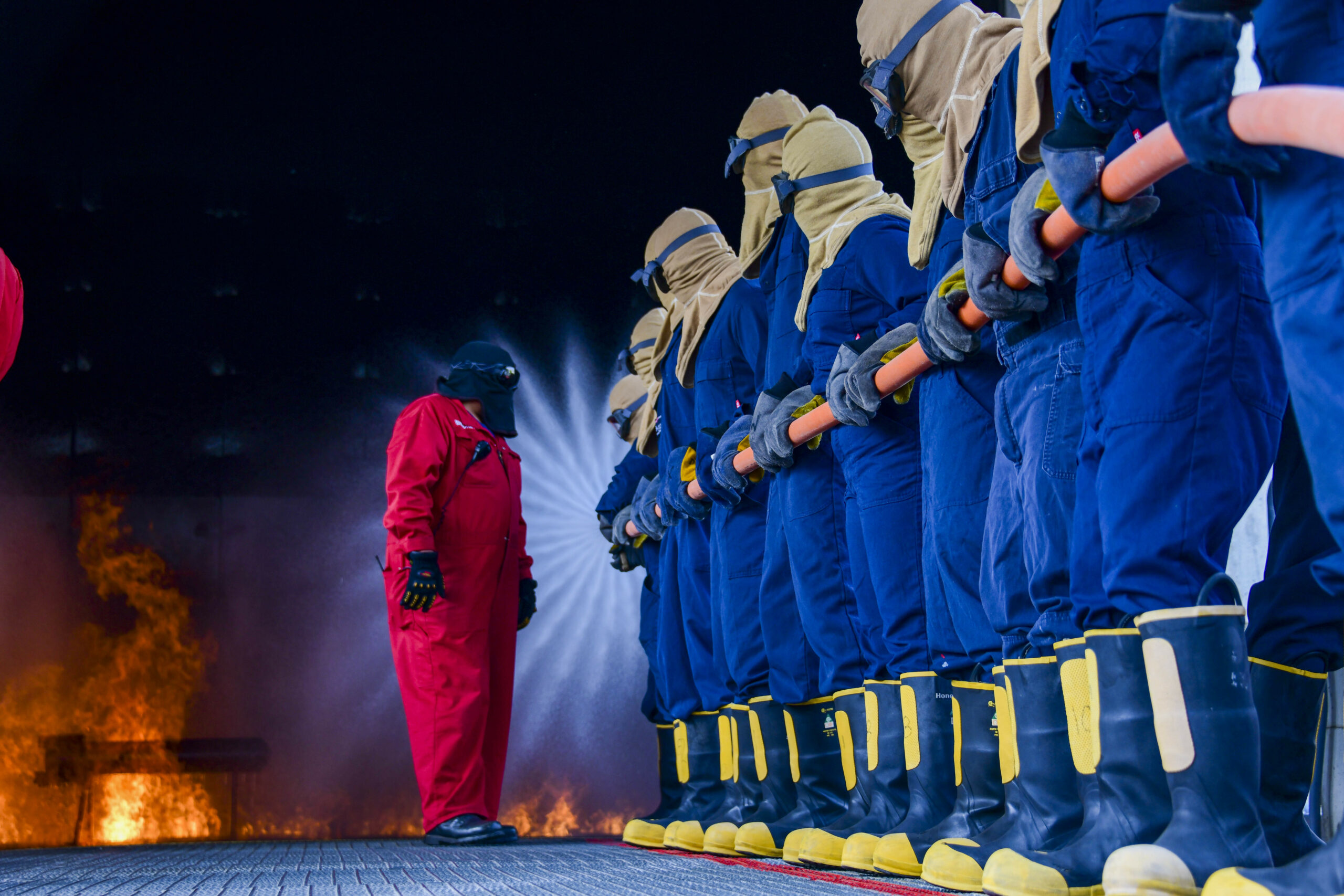
Fire resistance is a critical, required characteristic of many protective and personal clothing ensembles, whether for the likes of emergency ground crew at an air base, or firefighting teams aboard naval vessels.
Credit: US Navy/Mass Communication Specialist 3rd Class Erica Higa
For many of the abovementioned items, such as combat gear and uniforms, tents and shelters, camouflaged fabrics are used in order to disrupt and reduce the visibility of the wearer or equipment to optical and sensor threats, such as radar, thermal imagers (TI) and multi spectral sensors. With TI, specifically those with uncooled sensors, becoming increasingly widespread and miniaturised for use as modern thermal weapon sights, companies such as Switzerland’s SSZ Camouflage Technology have developed camouflage clothing systems and textiles to counter such threats as effectively as possible. As an example, the company’s lightweight sniper suit is treated in a way that makes it highly efficient in both visual and thermal signature reduction, which together with selected colour options, enable an individual soldier to merge with almost any environment.
While briefly mentioning Kevlar above, Dupont is also the company behind the Nomex range of FR-textile-based clothing systems, which includes: Nomex Essential 450A, Essential Arc 650 and Essential Ripstop 600. The Nomex Essential 450A fabric, for example, is engineered for pilots and aircrews to offer inherent flame protection – embodied in the fibres themselves – while minimising static discharge; the system is lightweight, comfortable and its FR protection meets US DoD MIL-C-83429B specification.
The 450A’s FR fabric gives protection for longer exposures and higher temperatures and is a plain weave Kevlar. Moreover, its Nomex antistatic-fibre blend with inherent FR cannot be washed away or worn out of the garment; it will also not melt or drip. A Dupont spokesperson told ESD that, “To meet growing needs for camouflage pattern, DuPont is closely working with leading mills in the Industry to offer 100% Nomex camouflage-printed fabrics for high-end, confined-space applications like tank crews and army flight personnel, as well as highly durable Nomex-blend camouflage fabrics for combat uniforms.”

Credit: Dupont
Keeping Warfighters Warm
Mentioned earlier, though looking at its research into new ways of protecting soldiers from extremes of cold, the Natick DEVCOM SC highlighted its recent work in 2022 in developing the Tactical HEated Apparel Technology, or TacHEAT, which enables actively heated protective clothing for troops operating in cold weather environments. The system, which has been rolled out slowly over the past two years, is designed to improve an individual’s lethality and existing mission performance in cold weather environments through improved tactility and dexterity, resulting in extended mission duration.
The DEVCOM SC, under the government’s Small Business Innovative Research (SBIR) programme, partnered with Human Systems Integration, Inc, to develop a new technology that embeds heating elements into the clothing system to prevent hypothermia, and protect hands and feet from frostbite. Using a combination of novel e-textiles and wearable technology, the centre’s longstanding textile technologist, Carol Winterhalter, led the development of an electronics-based system that can be powered by a soldier-worn battery, including the conformable wearable battery (CWB), to heat the resistive heating elements of the army combat shirt, gloves, briefs, and boot liners. The technology platform can be dropped into any clothing system, and the clothing and e-textile components can all be machine washed. Two TacHEAT systems are under development for both mounted and dismounted troops that are scalable and prevent heat loss around the body. The heated glove system is integrated into the combat shirt and gloves, and features a heater control module with a haptic switch for multiple heat levels, all powered by the CWB.
During FY 2020, the first prototype heated clothing systems were purchased directly by the US 160th Special Operations Aviation Regiment (Airborne) for evaluation with pilots and rear crew across their fleet of helicopters. The systems received positive feedback during the evaluation and a follow-on quota for more than 100 systems was requested for the 2021-2022 winter season. Additionally, a US Navy Special Operations Command group also purchased 12 TacHEAT systems in 2020; then, in 2021, the USAF purchased ten sets through a Defence Logistics Agency contract with all purchases to date qualifying as SBIR Phase III procurements.
Winterhalter, for her part, was awarded the Major General Harold Greene Best Innovation Individual Award in 2022 for her work and contribution to the programme, upon her retirement following a distinguished career as an expert textile technologist pioneering flame resistance, wool-blended uniforms and high-performance fibres to protect and enhance soldier performance well into the future.
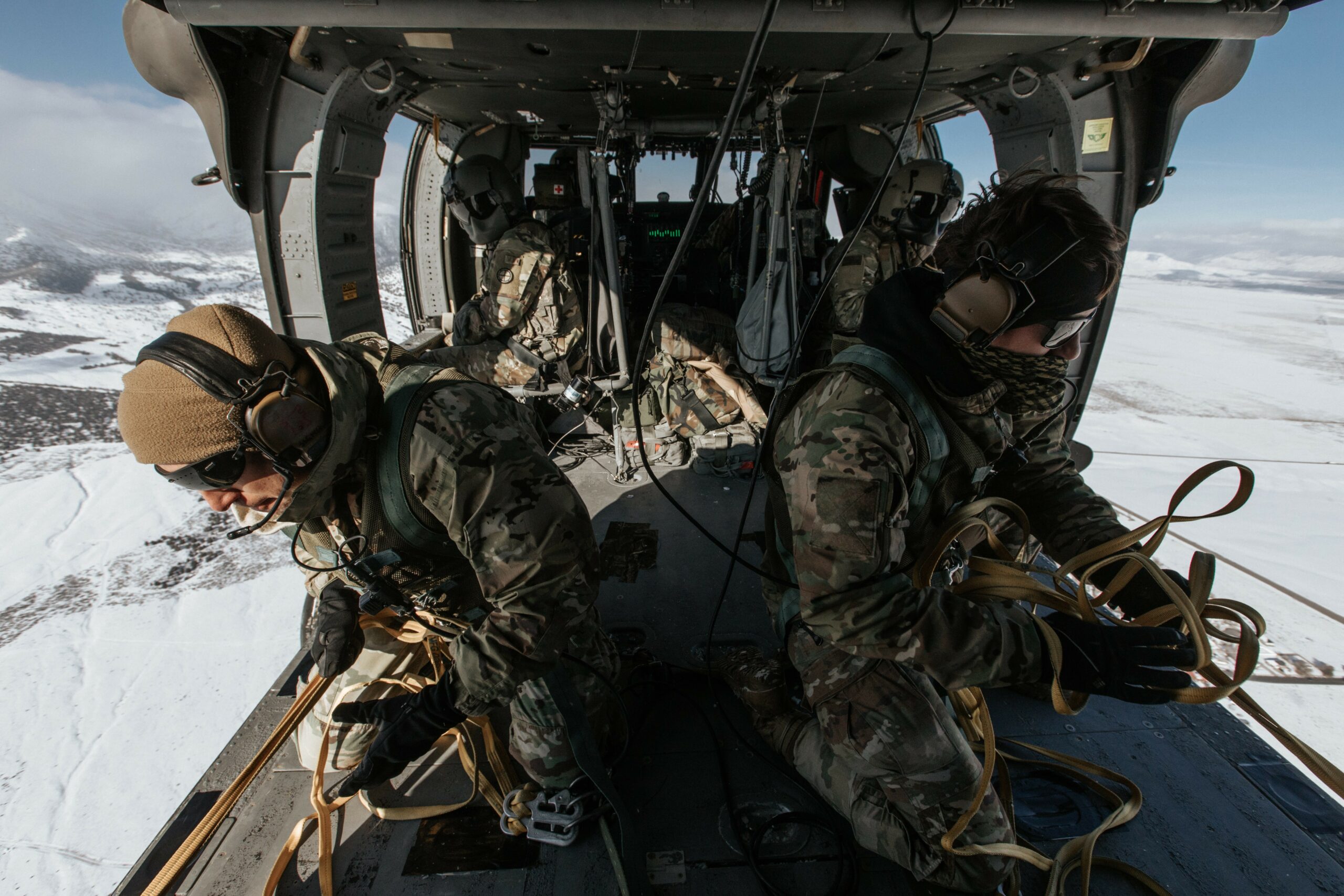
Credit: US Army/Spc Mackenzie Willden
Regarding TacHEAT, the centre said in a statement that the system was highly desired because, “it addresses the historic need to protect aircrew members from all branches of the military against exposure to cold weather elements in a manner that allows for continued dexterity of the hands and tactility of the fingers during flight operations and post jump/ejection sequence activities of rotary and fixed wing aircraft.” Endorsing those sentiments and the system itself, deputy product manager at Air Warrior (AW), James Isaacs, said that he expected “advancements of this technology may lead to improvements in lethality for aircrew by providing relief from cold environments where reduced tactility affects mission performance.” For its part, AW is a modular, integrated, rapidly reconfigurable combat aircrew ensemble, in which advanced textile technologies are being employed, designed to saves lives and maximise army aircrew mission performance.
Previous aviation life-support equipment consisted of a non-integrated assemblage of protective and survival gear, whereas AW uses a systems’ approach to equip aircrew and close the capability gap between human and machine. AW modules are being fielded incrementally in blocks to rapidly provide enhanced capabilities to soldiers and to leverage and integrate clothing and equipment, such as the army aircrew combat uniform and ballistic protection. The ultimate aim of AW is to provide enhanced mission effectiveness, leveraging advance textiles in clothing and equipment to maximise aircrew survivability.
TacHEAT should certainly fit well into AW plans. User feedback on the DEVCOM system is continuously provided to shape and finalise the two-system design for both mounted and dismounted operatives, in order to include modular and configurable power and electronic architectures being designed for manufacture under a SBIR Phase II contract. This SBIR Phase II effort is expected to significantly reduce the cost of prototype TacHEAT systems as they transition to low rate initial production and manufacture.
The Future
As technical textiles and wearable tech R&D make progress, it can be expected that further transformation of traditional fibres, yarns and textiles into highly sophisticated ‘smart textiles’ will take place. According to leading test and engineering textile technology company, James Heal, “Developments are being made to monitor and maintain records of physiological activities and vital signs using smart textiles in military garments and these innovations are designed with the wellbeing of the wearer in mind, bridging important gaps between military textiles, and other areas such as medical textiles.”

As to the future, Peter Goodwin, technical specialist at James Heal noted: “militaries can expect to see integrated devices and systems such as nanotechnology and skin-like camouflage, enabling automated detection of the environment, or threat, which will adjust functionality and/or protection level to adapt to external changes. The military textiles space is undergoing significant innovation.”
Tim Guest





